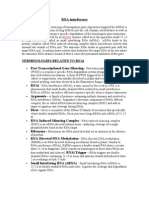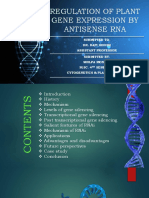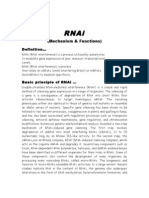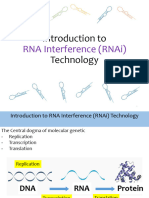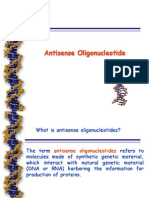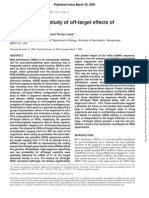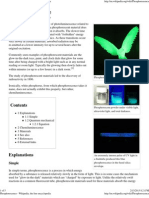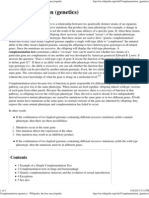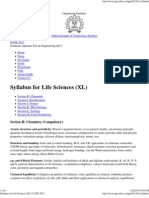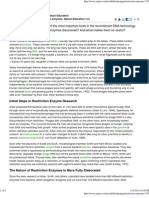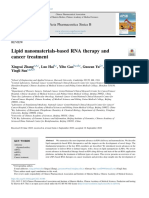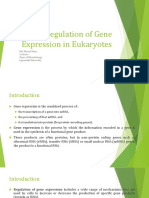BACKGROUND
RNA INTERFERENCE: THE NEXT GENETICS REVOLUTION?
Safia Wasi
RNA interference (RNAi) is arguably the hottest topic in science at present. The number of papers published on RNAi has exploded over the last few years and the journal Science proclaimed it the biggest scientific breakthrough of 2002. Why is RNAi causing such a fuss? Well, imagine you could identify the role of a gene in a disease by switching it off easily, in the space of just a day, and in almost any organism. Imagine you could then take this tool and treat certain diseases, such as cancer or AIDS, by switching off the causative genes. Thats the promise that RNAi offers. Around a decade ago, when Richard Jorgensen and colleagues were trying to produce more intensely purple petunias, they had little idea what impact their findings would have on science. They tried to improve the colour by adding another pigment-producing gene to petunias, but to their surprise, this turned them totally white or irregularly coloured. As the normal and foreign genes appeared to be turning each other off, they called this process co-suppression. What was initially thought to be a peculiar effect in petunias was subsequently found to occur in other plants. And curiosity was further aroused when a similar effect was detected in the fungus Neurospora crassa. Attempts to enhance orange pigment in the fungus by introducing extra copies of carotenoid pigment genes failed when the orange pigment gene was suppressed in a third of the engineered mould. In some strains, the effect which was called quelling was passed on through multiple generations. At the same time, Guo and Kemphus were investigating the function of the par-1 gene in the nematode worm Caenorhabditis elegans. They looked at the effect of blocking the production of the par-1 protein using a technique called antisense, in which a small synthesized piece of RNA that is complementary to a specific sequence in par-1 messenger RNA (mRNA) attaches and stops the mRNA from being translated into the protein. Injecting an antisense RNA into the worm gave the expected result: the embryos all died. But they were puzzled when injecting the sense strand (the same sequence as the par-1 mRNA) a standard negative control for the experiment also resulted in embryonic lethality. Andrew Fire and Craig Mello had observed a similarly confusing result in their studies, and devised an experiment that turned out to be a defining moment in RNAi research. They injected both sense and antisense RNAs into the worms to see if there was an additive effect, but found that this double-stranded RNA (dsRNA) mixture was much more potent than the sum of its parts, silencing the target gene ten times more efficiently than either strand alone. This effect became known as RNA interference. With the benefit of hindsight, it was clear that co-suppression in plants, quelling in fungi and RNAi in nematodes all shared a common mechanism. Further work showed that this effect was even more widespread, occurring in fruitflies and mammals too. Given the conservation of this mechanism in many organisms and given that this involved RNA, which for decades had been thought of as being only the intermediate that allowed DNA to be translated into proteins, scientists rushed to find out what was going on.
Dicing and silencing
The precise mechanisms behind RNAi are not yet fully understood, but what was established early on was that the gene-silencing effect occurs after the creation of RNA from DNA (transcription), because dsRNA created to target the introns (which are spliced out of the mRNA) did not activate RNAi hence the umbrella term of post-transcriptional gene silencing (PTGS) used to describe RNAi, co-suppression and quelling.
MAY 2003
UNDERSTANDING THE RNAissance
�BACKGROUND
RNA-induced silencing complex (RISC), which uses the antisense strand of the siRNA to bind to and degrade the corresponding mRNA, resulting in gene silencing. RNAi is astonishingly efficient, because the RISC is an enzyme and catalyses multiple rounds of RNAi, perhaps hundreds or thousands in vivo. It also shows an amazing persistence in some organisms, such as worms, which suggests there could also be an amplification response (FIG. 2).
Easy knockout
miRNA precursor
dsRNA
Dicer
Small RNA duplex
miRNA or siRNA
RISC
miRNA (stRNA) function
siRNA function
Incomplete pairing mRNA mRNA
Perfect pairing
Translational repression
mRNA destruction
Figure 1 | RNAi-mediated gene silencing. RNA interference (RNAi) is an apparently ancient defence mechanism against foreign double-stranded RNA (dsRNA). RNAs of just 22 nucleotides in length, called small interfering RNAs (siRNAs), are snipped from longer dsRNA chains by an enzyme called Dicer. The antisense strand of the siRNA is used by an RNAinduced silencing complex (RISC) to guide messenger RNA (mRNA) cleavage, so promoting mRNA degradation. Modified with permission from McManus, M. T. & Sharp, P. A. Gene silencing in mammals by small interfering RNAs. Nature Rev. Genet. 3, 737747 (2002) Macmillian Magazines Ltd. miRNA, microRNA; stRNA, small temporal RNA.
As RNAi relies on the sequence-specific interaction between siRNA and mRNA, siRNAs can be tailored to silence almost any gene. siRNAs that have been chemically synthesized or created by in vitro transcription systems can induce silencing in several systems, including mammalian cells. Transfected plasmids that produce dsRNA hairpins, called short hairpin RNAs (shRNAs), can also elicit RNAi effects. In the laboratory, the silencing of genes with RNAi seems to be rapid and convenient, and can be used to tackle many genes at the same time. RNAi can be achieved remarkably easily in C. elegans gene silencing occurs by direct feeding of dsRNA, feeding with bacteria that express dsRNA or even soaking worms in dsRNA, and the effect can also be transmitted to the next generation. The relative ease with which genes can be silenced using RNAi has caused a minor revolution in molecular biology. Armed with data from genome sequencing projects, gene silencing with RNAi can be used on a breathtaking scale. For example, Julie Ahringers group at the University of Cambridge has created a library of more than 16,000 cloned dsRNAs (around 86% of the C. elegans genome). By feeding these clones to worms, they have determined the function of 1,722 genes, most of which were previously unknown. Gary Ruvkuns group at Harvard Medical School has identified many hundreds of genes involved in fat storage. And Gregory Hannons group at Cold Spring Harbor are looking to determine the functions of every gene in the human genome. The list of projects in this area is seemingly endless.
Therapeutic possibilities
The central process of RNAi is the chopping of dsRNA into smaller pieces of a defined length by the appropriately named enzyme Dicer (FIG. 1). Dicer chops dsRNA into two classes of smaller RNAs microRNAs (miRNAs) and small interfering RNAs (siRNAs) that are around 2123 nucleotides in length. Although microRNAs also stop protein production (and, as described in another article, the boundaries between siRNAs and miRNAs is becoming blurred), siRNAs are thought to be the main protagonists in RNAi. Dicer delivers these siRNAs to a group of proteins called the
Taking the DNA sequence of a gene and designing dsRNA that can specifically and effectively silence a disease-related gene is analogous to monoclonal antibody production. There was an initial problem in developing therapeutic approaches, as dsRNAs that are 30 nucleotides in length or longer can trigger nonsequence-specific interferon responses in mammalian cells. But this has been overcome by delivering siRNAs into mammalian cells in culture. There are many ways of doing this, such as direct transfection of siRNAs into cells, creating an expression construct in which a promoter drives the production of both the sense and antisense siRNAs which then hybridize in the cell to produce the double-stranded siRNA, and using viral vectors to infect cells with an expression construct. Because of this, designing RNAi-based therapeutics is beginning to progress rapidly in certain areas.
UNDERSTANDING THE RNAissance
MAY 2003
�BACKGROUND
Dicer
Cytoplasm
RISC
RISC* Nucleus
Hairpin precursor
mRNA
Degradation Chromatin remodelling
mRNA
Translational inhibition
Figure 2 | A model for the mechanism of RNA interference. Silencing triggers in the form of double-stranded RNA can be presented in the cell as synthetic RNAs, replicating viruses or can be transcribed from nuclear genes. These are recognized and processed into small interfering RNAs (siRNAs) by Dicer. The double-stranded siRNAs are passed to the RNA-induced silencing complex (RISC), and the complex becomes activated by unwinding of the duplex. Activated RISC complexes can regulate gene expression at many levels. Almost certainly, such complexes act by promoting RNA degradation with siRNAs and translational inhibition with microRNAs. However, similar complexes probably also target chromatin remodelling. In plants, amplification of the silencing signal can also occur. Modified with permission from Hannon, G. RNA interference. Nature 418, 244251 (2002) Macmillian Magazines Ltd.
HIV. Several groups have shown that siRNAs can inhibit HIV replication effectively in culture. HIV infection can also be blocked by targeting either viral genes (for example, gag, rev, tat and env) or human genes (for example, CD4, the principal receptor for HIV) that are involved in the HIV life cycle. This is promising, as antiviral therapies that can attack multiple viral and cellular targets could circumvent genetic resistance of HIV. But these results have been achieved by transfecting the siRNAs into cells, and getting the siRNAs to function in vivo is likely to be a more difficult task. To get around the delivery problem, many groups have designed promoter systems that can express functional siRNAs when transfected into human cells. Early results have shown that this can decrease replication of HIV considerably and the group are currently working on inserting the system into a lentiviral vector to test its effectiveness in acute HIV-1 infections. Hepatitis. This has provided the first tangible evidence for RNAi as a therapy for diseases in live animals. Early RNAi studies noted that RNA silencing was prominent in the liver, which made this organ an attractive target for therapeutic approaches. Many immune-related liver diseases are characterized by apoptosis, which is mediated by a protein called Fas. So Judy Liebermans group injected siRNA targeting Fas intravenously into two models of autoimmune hepatitis in mice. This decreased
Fas mRNA and protein levels in hepatocytes and protected the cells against liver injury from apoptosis, even when siRNA was administered after the induction of injury. Extending these findings to other liver diseases looks hopeful, but the authors concluded that other strategies, such as viral vectors, might be required to target organs in which RNA silencing is less effective than in the liver. Cancer. Gregory Hannon and colleagues have used RNAi to silence expression of p53 the guardian of the genome, which protects against any tumour-associated DNA damage by introducing several p53-targeting shRNAs into stem cells and looking at the effect in mice. The shRNAs produced a wide range of clinical effects, ranging from benign to malignant tumours, the severity and type of which correlated with the extent to which the shRNA had silenced p53. As tumour suppressors such as p53 usually work as part of a complex and finely regulated network, the ability to dampen these networks to varying degrees in these libraries which the authors term an epi-allelic series of hypomorphic mutations will be of enormous value when it comes to investigating the early stages of disease. The success of these modified stem cells also gives hope that this could treat diseases in which stem cells can be modified ex vivo and then re-introduced into the affected individual.
UNDERSTANDING THE RNAissance
MAY 2003
�BACKGROUND
Researchers at the charity Cancer Research UK and the Netherlands Cancer Institute have recently announced that they intend to generate a large library of human cells, each containing a silenced gene. They initially want to silence 3008,000 cancer genes, and hope to eventually cover the entire human genome. Their aim is to uncover all the genes that become overexpressed in human cancers and to find out precisely what needs to be taken away from a cancerous cell in order to make it normal again.
Why RNAi?
Many mysteries of RNAi have yet to unfold, but one thing that is certain is that these small RNAs have revolutionized the way scientists think about how DNA, RNA and proteins are controlled and function. This has caught the imagination of both big pharmaceutical companies, which are using RNAi as a target validation tool, and smaller companies, which are optimizing RNAi methodologiesand looking at therapeutic avenues. With some of these companies predicting that the first RNAi-based drugs will begin clinical trials in the next 23 years, these might be early days, but they are incredibly exciting ones.
FURTHER READING Carmell, M. A., Zhang, L., Conklin, D. S., Hannon, G. J. & Rosenquist, T. A. Germline transmission of RNAi in mice. Nature Struct. Biol. 10, 9192 (2003). Hammond, S. M., Caudy, A. A. & Hannon, G. J. Post-transcriptional gene silencing by double-stranded RNA. Nature Rev. Genet. 2, 110119 (2001). Hemann, M. T. et al. An epi-allelic series of p53 hypomorphs created by stable RNAi produces distinct tumor phenotypes in vivo. Nature Genet. 33, 396400 (2003). McManus, M. T. & Sharp, P. A. Gene silencing in mammals by small interfering RNAs. Nature Rev. Genet. 3, 737747 (2002). Song, E. et al. RNA interference targeting Fas protects mice from fulminant hepatitis. Nature Med. 9, 347351 (2003). Zamore, P. D, Tuschl, T., Sharp, P. A., & Bartel, D. P. RNAi: double-stranded RNA directs the ATP-dependent cleavage of mRNA at 21 to 23 nucleotide intervals. Cell 101, 2533 (2000).
It is thought that RNAi, at least in plants, might be an ancient defence mechanism that defends against RNA viruses, transposons and repetitive sequences. But recent work in yeast and the ciliate Tetrahymena has shown that RNAi might also influence transcription in the cell nucleus, partly by determining the form of the chromatin in which the DNA is wrapped (FIG. 2). So, which genes are transcribed and which remain wrapped up or hidden could be under the control of small RNAs, although how this mechanism works is currently unknown.
UNDERSTANDING THE RNAissance
MAY 2003




